Highly Stable Flexible Organic Electrochemical Transistors with Natural Rubber Latex Additives
- PMID: 39204507
- PMCID: PMC11359245
- DOI: 10.3390/polym16162287
Highly Stable Flexible Organic Electrochemical Transistors with Natural Rubber Latex Additives
Abstract
Organic electrochemical transistors (OECTs) have attracted considerable interest in the context of wearable and implantable biosensors due to their remarkable signal amplification combined with seamless integration into biological systems. These properties underlie OECTs' potential utility across a range of bioelectronic applications. One of the main challenges to their practical applications is the mechanical limitation of PEDOT:PSS, the most typical conductive polymer used as a channel layer, when the OECTs are applied to implantable and stretchable bioelectronics. In this work, we address this critical issue by employing natural rubber latex (NRL) as an additive in PEDOT:PSS to improve flexibility and stretchability of the OECT channels. Although the inclusion of NRL leads to a decrease in transconductance, mainly due to a reduced carrier mobility from 0.3 to 0.1 cm2/V·s, the OECTs maintain satisfactory transconductance, exceeding 5 mS. Furthermore, it is demonstrated that the OECTs exhibit excellent mechanical stability while maintaining their performance even after 100 repetitive bending cycles. This work, therefore, suggests that the NRL/PEDOT:PSS composite film can be deployed for wearable/implantable applications, where high mechanical stability is needed. This finding opens up new avenues for practical use of OECTs in more robust and versatile wearable and implantable biosensors.
Keywords: PEDOT:PSS; elastomer; flexible OECTs; natural rubber latex; stretchable.
Conflict of interest statement
The authors declare no conflicts of interest.
Figures




Similar articles
-
Additive Blending Effects on PEDOT:PSS Composite Films for Wearable Organic Electrochemical Transistors.ACS Appl Mater Interfaces. 2024 Mar 20;16(11):13384-13398. doi: 10.1021/acsami.3c14961. Epub 2024 Mar 8. ACS Appl Mater Interfaces. 2024. PMID: 38454789 Free PMC article.
-
Biocompatible Ionic Liquids in High-Performing Organic Electrochemical Transistors for Ion Detection and Electrophysiological Monitoring.ACS Nano. 2022 Aug 23;16(8):12049-12060. doi: 10.1021/acsnano.2c02191. Epub 2022 Aug 8. ACS Nano. 2022. PMID: 35939084
-
Vertically Phase-Separated PEDOT:PSS Film via Solid-Liquid Interface Doping for Flexible Organic Electrochemical Transistors.ACS Appl Mater Interfaces. 2025 Mar 19;17(11):17202-17216. doi: 10.1021/acsami.5c01311. Epub 2025 Mar 11. ACS Appl Mater Interfaces. 2025. PMID: 40066734
-
Organic Electrochemical Transistors (OECTs) Toward Flexible and Wearable Bioelectronics.Molecules. 2020 Nov 13;25(22):5288. doi: 10.3390/molecules25225288. Molecules. 2020. PMID: 33202778 Free PMC article. Review.
-
Functionalized Organic Thin Film Transistors for Biosensing.Acc Chem Res. 2019 Feb 19;52(2):277-287. doi: 10.1021/acs.accounts.8b00448. Epub 2019 Jan 8. Acc Chem Res. 2019. PMID: 30620566 Review.
Cited by
-
Influence of Surface Texture in Additively Manufactured Biocompatible Materials and Triboelectric Behavior.Materials (Basel). 2025 Jul 17;18(14):3366. doi: 10.3390/ma18143366. Materials (Basel). 2025. PMID: 40731576 Free PMC article. Review.
References
-
- Nissa J., Janson P., Simon D.T., Berggren M. Expanding the understanding of organic electrochemical transistor function. Appl. Phys. Lett. 2021;118:053301. doi: 10.1063/5.0039345. - DOI
-
- Wang L., Yue X., Sun Q., Zhang L., Ren G., Lu G., Yu H.-D., Huang W. Flexible organic electrochemical transistors for chemical and biological sensing. Nano Res. 2022;15:2433. doi: 10.1007/s12274-021-3856-3. - DOI
-
- Gao L., Wu M., Yu X., Yu J. Device design principles and bioelectronic applications for flexible organic electrochemical transistors. Int. J. Extrem. Manuf. 2024;6:012005. doi: 10.1088/2631-7990/acfd69. - DOI
Grants and funding
LinkOut - more resources
Full Text Sources

